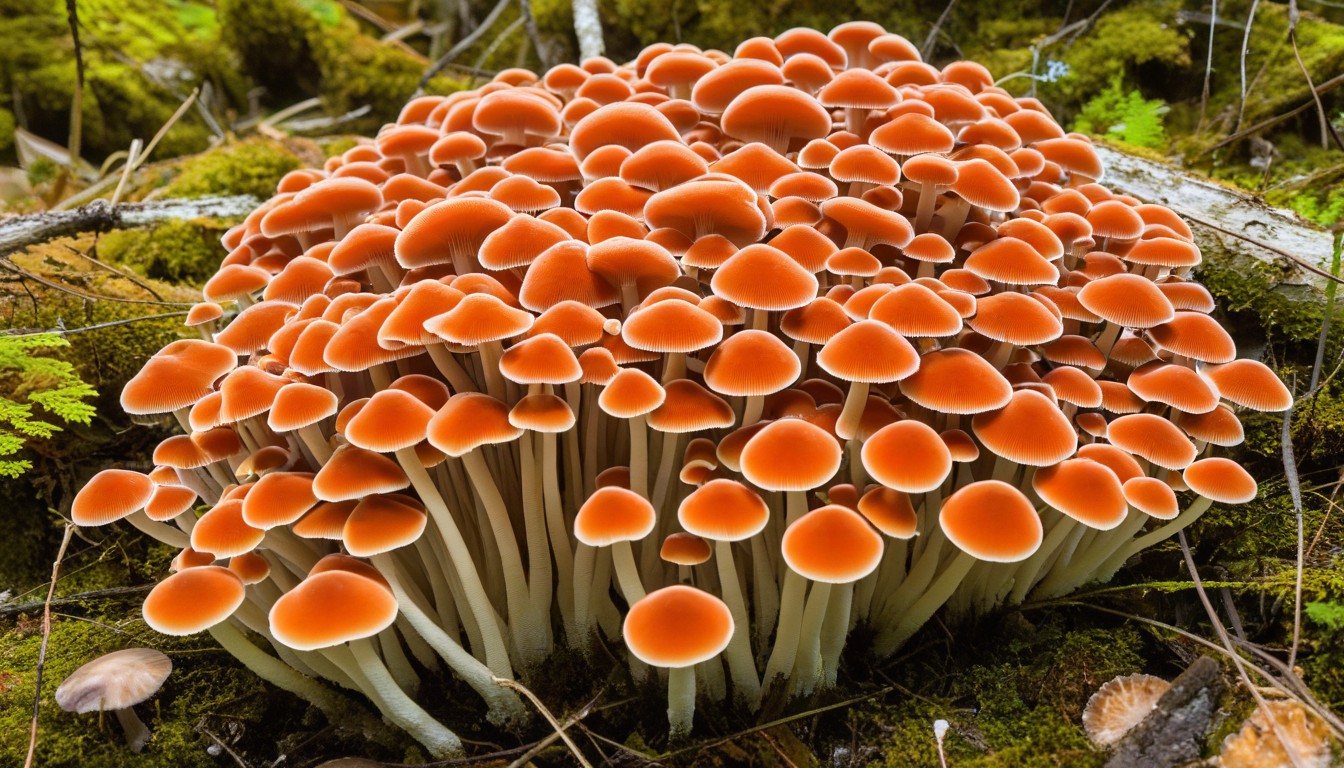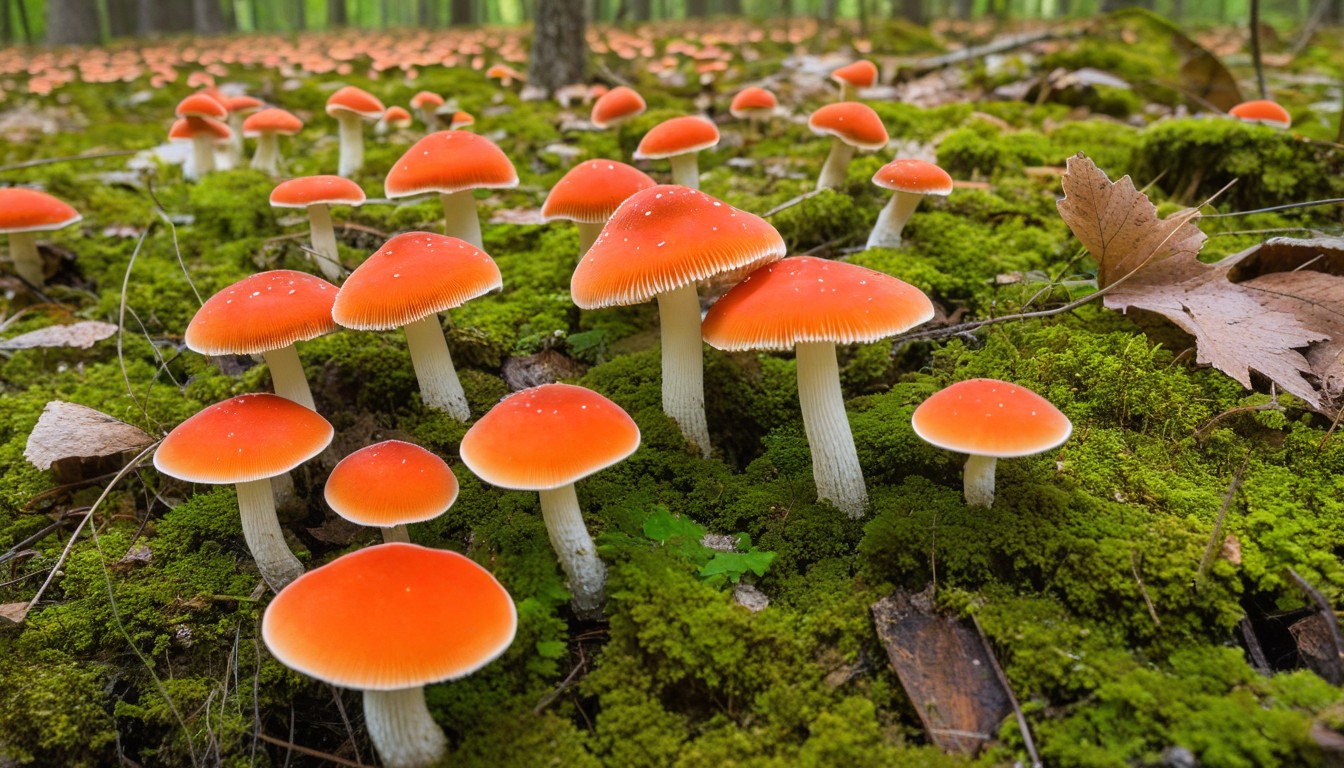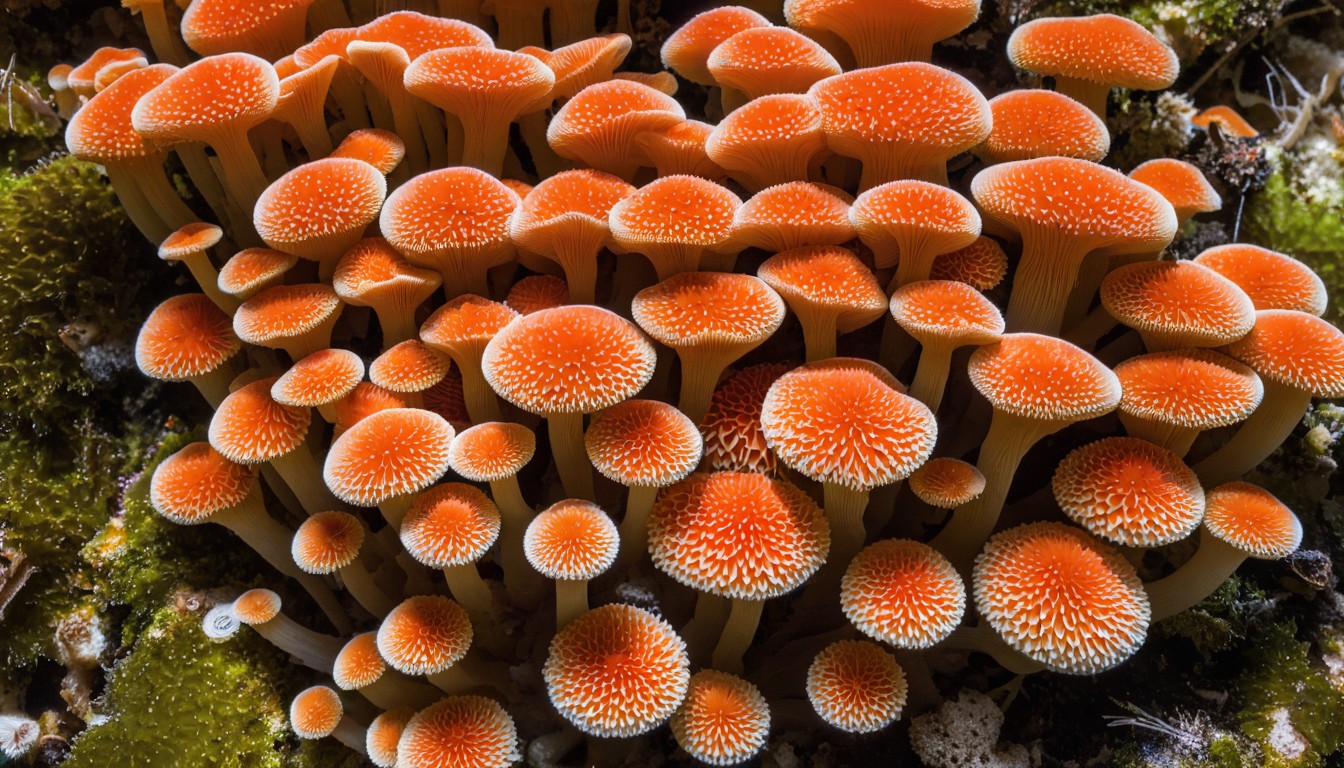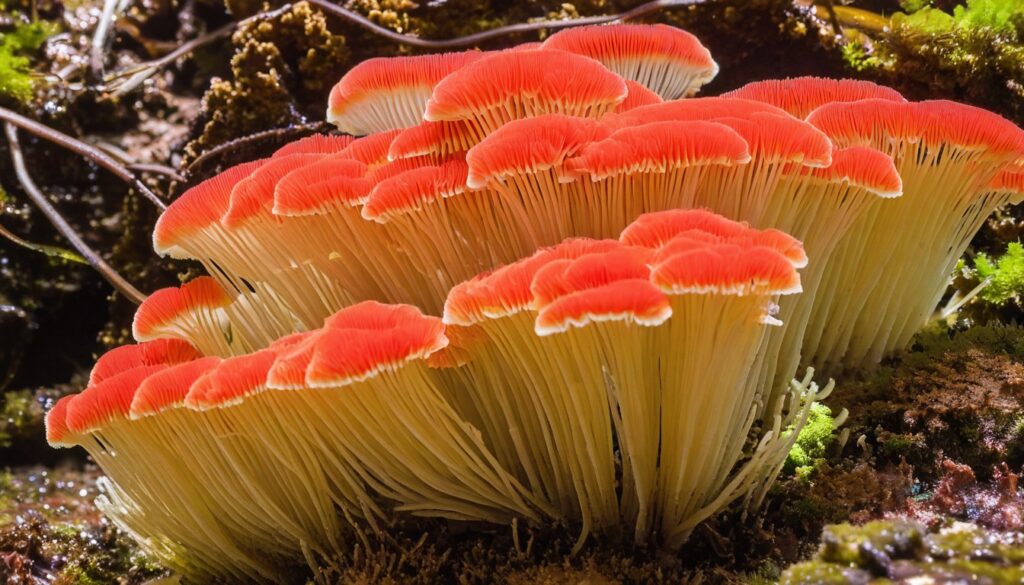If you’re an adventurous forager seeking unique and exciting mushrooms to add to your collection, look no further than Idaho’s wilderness. Among the diverse range of fungi growing in the Gem State, Coral Mushrooms reign supreme as one of the most visually stunning and sought-after species.
With their vibrant colors and intricate shapes resembling sea coral, these mushrooms are a favorite among nature lovers, photographers, and food enthusiasts alike. In this article, we’ll uncover the wonders of Coral Mushrooms in Idaho, from their distinct physical characteristics to their culinary and medicinal benefits.
Key Takeaways:
- Idaho is a prime location for foraging Coral Mushrooms.
- Coral Mushrooms are visually stunning and come in a variety of shapes and colors.
- Identifying and foraging Coral Mushrooms requires proper safety precautions.
- Coral Mushrooms are highly valued for both their culinary and medicinal properties.
- Preserving and storing Coral Mushrooms can extend their shelf life and freshness.
What are Coral Mushrooms?
Coral mushrooms are a type of mushroom that belongs to the Clavariaceae family. They are easily distinguishable from other mushroom species due to their long, coral-like branches and vibrant colors. These unique mushrooms play a vital role in the ecosystem of Idaho’s wild landscapes, providing important nutrients to the soil and serving as a food source for numerous animals.
There are many different species of coral mushrooms found in Idaho, each with distinct characteristics, colors, and shapes. Some of the most common species found in the state include the golden coral, the pink tipped coral, and the violet coral.
Coral mushrooms are highly valued in traditional Chinese medicine for their medicinal properties. They have been found to possess anti-inflammatory and immune-boosting properties, making them a popular natural remedy for ailments such as arthritis and allergies.
Overall, coral mushrooms are a fascinating and unique type of mushroom that are cherished by nature enthusiasts and foragers alike. In the following sections, we will explore the various types of coral mushrooms found in Idaho, how to identify and forage for them safely, and even some delicious recipes for cooking with these flavorful mushrooms.
Types of Coral Mushrooms Found in Idaho
Idaho is home to a variety of coral mushroom species with distinct shapes, sizes, and colors. The following table provides an overview of the most common types of coral mushrooms found in Idaho:
Type of Coral Mushroom | Characteristics |
|---|---|
Sarcodontia setosa | Also known as the “shingled hedgehog,” has a reddish-brown to yellowish-brown color and features spines on its underside. |
Ramaria botrytis | Recognizable by its distinctive upright structure and branching, coral-like formations. It ranges in color from pale yellow to bright orange. |
Clavulina coralloides | Nicknamed the “coral fungus,” this mushroom is white with a coral-like structure, which makes it popular in decorative uses. |
Clavicorona pyxidata | Forms a distinctive crown shape with pale yellow or brownish-yellow branches, often with a dark-brown center. |
Peniophora albobadia | Has a white to grayish-brown or pale tan color and grows in small clusters, featuring a maze-like structure. |
Coral mushrooms are known for their unique appearance and can be found in different environments across Idaho, from alpine forests to wetlands and prairies. With caution and the correct knowledge, finding and identifying these fascinating species can be exciting for mushroom enthusiasts and nature lovers alike.
Identifying Coral Mushrooms

As coral mushrooms come in various shapes, sizes, and colors, identifying them requires keen observation and attention to detail. Here are some expert tips and tricks that can help you distinguish coral mushrooms from other types of fungi:
Characteristic | Description |
|---|---|
Branching structure | Coral mushrooms have a distinctive coral-like structure composed of multiple branches that extend from a central point. |
Bright coloration | Most coral mushrooms have vibrant colors such as orange, red, pink, and yellow, making them stand out among other fungi species in the wild. |
Central stalk | Some coral mushrooms have a central stalk that divides into branches, while others have multiple branches without a defined stalk. |
Distinctive smell | Some coral mushrooms have a unique odor that can be described as sweet or fruity, which can help differentiate them from other fungi. |
Spore prints | Making a spore print can further aid in identifying coral mushrooms. Spore prints of coral mushrooms typically range from white to pale pink in color. |
Remember that some coral mushrooms have toxic look-alikes, so it is important to be certain of your identification before consuming any mushrooms for culinary use. When in doubt, consult with a local expert or mycologist.
The Best Time and Places to Find Coral Mushrooms in Idaho

Foraging coral mushrooms in Idaho’s wilds is an adventure that requires proper planning and timing to ensure success. The best time to find coral mushrooms in Idaho is during the fall season, specifically between September and November, after the first rainfall of the season. During these times, the weather is usually cool and damp, providing the perfect growing conditions for these mushrooms.
When it comes to the best places to find coral mushrooms in Idaho, the state boasts a variety of locations that are known to be hotspots for foragers. Some of the most popular places include the forests surrounding the Sawtooth Mountains, the Selkirk Mountains, and the Clearwater National Forest. Additionally, coral mushrooms can also be found in areas with decomposing logs and wood chips, so it’s worthwhile to explore these locations as well.
Best Time to Find Coral Mushrooms | Best Places to Find Coral Mushrooms |
|---|---|
September to November | Sawtooth Mountains |
Selkirk Mountains | |
Clearwater National Forest | |
Areas with decomposing logs and wood chips |
It’s important to note that specific locations can shift from year to year depending on the weather and other environmental factors. Therefore, it’s crucial to do your research and ask experienced local foragers to ensure you are directed to the right areas. With proper timing and planning, you can enjoy a successful foraging experience and discover the beauty and flavor of Idaho’s coral mushrooms.
Safety Precautions for Foraging Coral Mushrooms
Foraging is a thrilling way to connect with nature and discover the delights of wild edibles, but it’s essential to take safety precautions when collecting coral mushrooms. Not all mushrooms are safe to eat, and some can be deadly if ingested.
Identifying Poisonous Look-Alikes
One of the most crucial safety measures when foraging coral mushrooms is to identify poisonous look-alikes accurately.
Safe Coral Mushrooms | Poisonous Look-Alikes |
|---|---|
Clavulina cristata | Hydnum repandum |
Clavicorona pyxidata | Galerina marginata |
Ramaria araiospora | Amanita muscaria |
Proper Handling Techniques
When collecting coral mushrooms, it’s crucial to handle them properly to avoid contamination. Follow these guidelines:
- Wear gloves and use a clean knife to cut the mushrooms at their base gently.
- Avoid collecting specimens that show signs of decay or insects.
- Keep harvested mushrooms in a basket or cloth bag to allow for air circulation and avoid trapping moisture.
By taking these safety precautions, you can have a safe and successful coral mushroom foraging experience.
Harvesting Coral Mushrooms Sustainably

Foraging for coral mushrooms is an exciting activity, but as with any form of harvesting, it’s important to do so sustainably. Ethical harvesting ensures that you’re not damaging the ecosystem for future generations. Here are some tips for harvesting coral mushrooms sustainably:
- Only harvest mature specimens that have already released their spores.
- Use a sharp knife to cleanly cut the mushrooms at the base, leaving behind the mycelium and any small specimens.
- Harvest in small quantities and avoid taking every mushroom you come across. Leave plenty behind for wildlife and ecological balance.
- Take care not to damage nearby vegetation, soil, or other wildlife.
- Be aware of local regulations or restrictions on foraging and follow them accordingly.
By following these tips, you’ll be able to enjoy harvesting coral mushrooms without causing harm to the environment. This sustainable approach ensures that this fungi will continue to thrive in Idaho’s wilds for years to come.
Culinary Delights: Cooking with Coral Mushrooms
Coral mushrooms offer a unique flavor and texture to any dish, making them a versatile and exciting ingredient to use in the kitchen. Their delicate, branch-like structure and vibrant colors add an element of artistry to any meal presentation.
These mushrooms are best used in dishes with simple, complementary flavors that allow their distinct taste to shine through. One popular option is to sauté them with garlic and olive oil, then mix them with pasta for a hearty and flavorful meal. Another idea is to incorporate them into a vegetable stir-fry or a risotto, where they pair well with other earthy flavors.
Did you know? According to research, coral mushrooms contain high levels of antioxidants and have potential anti-inflammatory properties.
Coral Mushroom Frittata Recipe
Ingredients: | Instructions: |
|---|---|
6 eggs | Preheat the oven to 350°F (175°C). |
1/4 cup grated parmesan cheese | Heat a skillet over medium heat. Sauté 1 cup of chopped coral mushrooms until softened. Add the chopped mushroom mixture to the eggs and stir. |
1 cup chopped coral mushrooms | Pour the egg mixture back into the skillet and cook on medium heat for 2-3 minutes. |
1 clove minced garlic | Sprinkle the remaining grated cheese over the eggs and place in the oven. Bake for 5-7 minutes, or until the frittata is set. |
2 tablespoons olive oil | Serve hot and enjoy! |
This coral mushroom frittata recipe is a perfect brunch dish and a great way to showcase the mushrooms’ unique flavor and texture. Experimenting with different recipes and cooking techniques will inspire you to discover new and exciting ways to incorporate these delicious mushrooms into your cooking.
Medicinal and Nutritional Benefits of Coral Mushrooms

Coral mushrooms are not only a culinary delight but also a source of numerous health benefits. They are low in calories, high in fiber, and rich in vitamins and minerals, making them a valuable addition to a healthy diet. Here are some of the nutritional benefits of coral mushrooms:
Nutrient | Amount per 100g |
|---|---|
Protein | 3g |
Dietary Fiber | 2g |
Vitamin D | 7.6 μg |
Vitamin B12 | 6.4 μg |
Niacin | 12 mg |
Potassium | 448 mg |
Coral mushrooms are also known for their medicinal properties and have been traditionally used for their healing benefits. They possess antioxidant and anti-inflammatory properties that can help boost the immune system, reduce inflammation, and fight against chronic diseases such as cancer, heart disease, and diabetes. Some of the medicinal benefits of coral mushrooms are:
- Boosts immune system: Coral mushrooms contain beta-glucans, which stimulate the immune system, helping the body fight against infections and diseases.
- Anti-inflammatory: Coral mushrooms possess anti-inflammatory properties, which can help reduce inflammation in the body, leading to a healthier gut and improved joint health.
- Antioxidant: Coral mushrooms are rich in antioxidants, which can help protect the body against cell damage caused by free radicals.
- Reduce Cholesterol: Coral mushrooms contain compounds that can lower LDL-cholesterol levels in the blood, reducing the risk of heart disease.
Whether enjoyed for their flavor or their numerous health benefits, coral mushrooms are definitely worth incorporating into your diet.
Preserving and Storing Coral Mushrooms
After a successful foraging trip, it’s essential to properly preserve and store your coral mushrooms to maintain their freshness and flavor. Here are some effective methods:
Dehydration
One of the best ways to preserve coral mushrooms is by dehydrating them. First, clean and slice the mushrooms into thin pieces. Then, lay them in a single layer on a parchment paper-lined baking sheet and place them in an oven at the lowest temperature possible. Let them dry out for several hours until they are completely dehydrated. Store them in an airtight container in a cool, dry place, and they’ll last for several months.
Freezing
Freezing is another effective method for preserving coral mushrooms. Clean and slice the mushrooms as directed for dehydration, then blanch them in boiling water for one minute. Drain and spread them out on a baking sheet to cool down. Once they’re cool, transfer them to a freezer-safe container or bag, and store them in the freezer for up to six months.
Canning
If you’re looking for a long-lasting preservation method, canning is a viable option. To can coral mushrooms, clean them thoroughly and pack them tightly into sterilized glass jars. Fill the jars with boiling water, leaving a half-inch headspace at the top. Seal the jars tightly and process them in a pressure canner according to the manufacturer’s instructions. Canned coral mushrooms can last for up to one year when stored in a cool, dry place.
Now that you know how to preserve and store your coral mushrooms, you can enjoy their delicious flavor and numerous health benefits all year round!
Coral Mushrooms: A Nature Photographer’s Delight
The unique and vibrant forms of coral mushrooms make them a captivating subject for nature photographers. With their intricate branching structures and striking colors, these mushrooms can be found in a variety of shapes and sizes, ranging from small coral-like clusters to large, ornate fans.
Capturing the beauty of coral mushrooms requires a keen eye for detail and a willingness to explore the natural landscapes where they thrive. When photographing coral mushrooms, consider the lighting and background to create stunning compositions that showcase the intricate details of each mushroom.
Whether you are an experienced nature photographer or just starting out, coral mushrooms offer endless possibilities for artistic expression and creative exploration. So grab your camera and head into the wilds of Idaho to discover the magic of these fascinating fungi.
Conclusion
Exploring the wilds of Idaho and discovering the beauty and bounty of coral mushrooms is a thrilling adventure for nature enthusiasts and foodies alike. From identifying the different species to learning how to sustainably harvest and cook them, there’s so much to discover and enjoy. But before you venture out to forage, remember to always follow safety precautions and respect the ecosystem. With a little patience and practice, you too can experience the wonder and excitement of uncovering these hidden treasures in Idaho’s wilderness. Happy foraging!
FAQ
What are coral mushrooms?
Coral mushrooms are a type of fungus that grow in a distinctive branching shape resembling coral. They can be found in the wild, including in the forests of Idaho.
What types of coral mushrooms can be found in Idaho?
There are several species of coral mushrooms that can be found in Idaho, including Clavulina coralloides, Ramaria stricta, and Clavicorona pyxidata. Each species has its own unique characteristics.
How can I identify coral mushrooms?
Identifying coral mushrooms can be done by observing their branching structures and colors. They typically have vibrant hues, ranging from white to orange, yellow, or pink. It is important to consult field guides or seek expert advice to ensure accurate identification.
When and where is the best time to find coral mushrooms in Idaho?
Coral mushrooms are most commonly found in the late summer and fall, usually after significant rainfall. They thrive in moist environments, often growing near decaying wood or in forested areas. Some popular areas in Idaho for coral mushroom foraging include national forests, state parks, and wilderness areas.
What safety precautions should I take when foraging coral mushrooms?
When foraging coral mushrooms, it is essential to be cautious and follow safety guidelines. These precautions include wearing protective gloves, properly identifying mushrooms, avoiding consumption of unknown species, and avoiding areas that may have been contaminated or treated with chemicals.
How can I harvest coral mushrooms sustainably?
To harvest coral mushrooms sustainably, it is important to only take what you need, leaving a portion of the mushrooms behind to ensure their continued growth and reproduction. Always harvest with care, using a sharp knife to cut the mushrooms at the base and minimizing disruption to the surrounding ecosystem.
What are the culinary uses of coral mushrooms?
Coral mushrooms have a delicate flavor and a slightly crunchy texture, making them a popular ingredient in various culinary dishes. They can be sautéed, stir-fried, added to soups, stews, or used as a topping for pasta and risotto. They pair well with herbs, garlic, and other savory ingredients.
Are there any medicinal or nutritional benefits of coral mushrooms?
Coral mushrooms are known to possess various medicinal properties and nutritional benefits. They are rich in antioxidants, vitamins, and minerals, which can support a healthy immune system and provide anti-inflammatory effects. However, it is important to consult a healthcare professional before using them for medicinal purposes.
How can I preserve and store coral mushrooms?
To preserve and store coral mushrooms, it is recommended to clean them and remove any dirt or debris. They can be stored in a paper bag or wrapped in a paper towel to absorb excess moisture. Refrigeration is advisable, and they should be consumed within a few days for optimal freshness.
Can coral mushrooms be appreciated through nature photography?
Yes, coral mushrooms make excellent subjects for nature photography. Their vibrant colors and unique shapes create visually captivating images. Photographers can experiment with different angles, lighting, and compositions to capture the beauty of coral mushrooms in their natural habitat.

